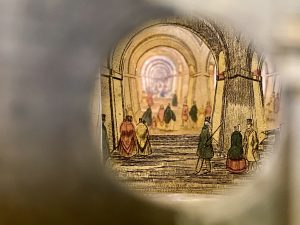While the Thames Tunnel is still considered an engineering marvel, the end of the story was not as glamorous as originally intended, when it became a financial liability to the owners and was sold and eventually incorporated into the London Underground system in 1865.
The Thames Tunnel which links the two shores of the river was made possible by the mind of Marc Isambard Brunel (1769-1849) and the skills and hard labour of architects, engineers and miners, all of whom worked (and some lost their lives) at the first tunnel under a navigable river.
Although today the idea of a tunnel under a river or any tunnel is commonplace, that was not at all the case back in the 1820´s. To bend nature to humanity’s will and to find solutions to otherwise impossible feats was nothing new but to turn such an idea into reality was truly something unique.
With the Tunnel connecting Rotherhithe to Wapping, Marc Brunel wanted a passageway for goods and pedestrians to be brought back and forth between both sides of the river. Naturally, it was intended for such an ideal to produce too.Works started in 1825 and went on until 1843, when it was finally inaugurated with great pomp. In those 18 years the Thames Tunnel encountered several issues, including lack of funds, water bursting from above during excavation and the need to constantly convince those around that the endeavour was, indeed, a valid and important one.
Having completed the tunnel was in itself a great accomplishment but by 1843 there was no more money to build ramps by which horses and carts, and the goods they carried, could enter the Tunnel. A major goal of the structure, one which would have made it more likely to be profitable, was gone, and soon the interest and novelty of it wore off. After a great surge of visitors and curiosity, the Thames Tunnel Company had to face the reality that being a simple passageway for people to cross from one side of the river to the other was not profitable enough to keep the tunnel as it was or invest more money into it.

View through a paper peepshow depicting visitors to the Thames Tunnel, about 1843. Brunel Museum, London, LDBRU:2003.20
Only 3 years after the grand opening of the Tunnel, in March of 1846, it was reported in The Times that at a director board meeting of Thames Tunnel Company the idea of selling the Tunnel was discussed and advised to be accepted by those in the know.[1]
Even engineering marvels end up losing their importance when overshadowed by other and new projects. The tunnel under the Thames was, at its inception and construction, truly one of a kind.
But with no further fund injections, its owners took advantage of the boom in railway construction and expansion throughout Britain and sold the tunnel in 1865 to the East London Railway Company, as reported by The Times on June of the same year. [2]

East London Line commemorative medal showing the Thames Tunnel, 2007. Brunel Museum, London, LDBRU:2007.3
They in turn laid down tracks and the first steam train finally passed through the Tunnel in 1869, when the line was part of plans to link the North and South of the country.
The importance of the Thames Tunnel is little known by the general public – even in London. In the end, one of the most significant works of engineering of the 1800s is taken for granted as simply part of a well-oiled system of public transportation, in itself a testament to the original idea and everlasting influence of the Tunnel.
Today the tunnel is part of London’s modern Overground system, more specifically part of the Windrush line as of 2010.
This post was written by Pedro Briggs and developed as part of an internship program at the Brunel Museum during the Winter/Spring of 2025. The internship and blog formed part of his assessment for his MA in History at Queen Mary University of London, and were part of studies into public history and the work of the heritage sector.
References:
[1] “The Thames Tunnel”, The Times, 5 Mar. 1846, p. 6.
[2] “The Writing Lesson”, The Times, 17 Jun. 1865, p.3.
